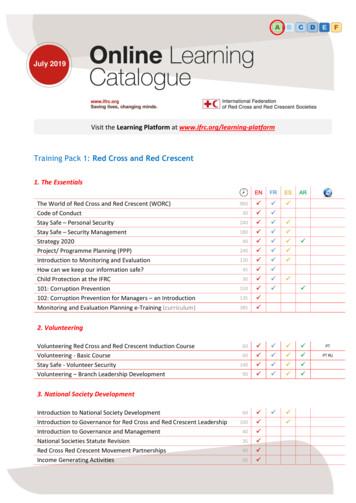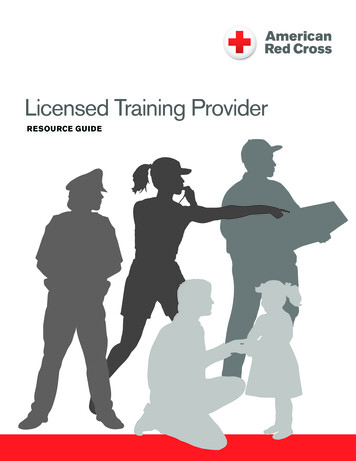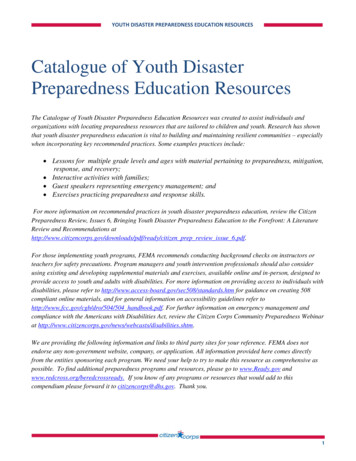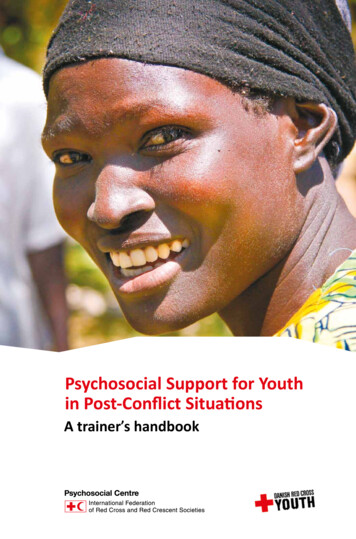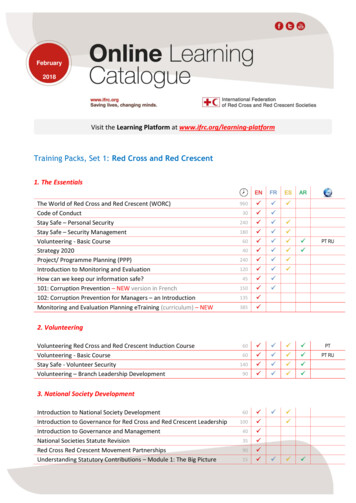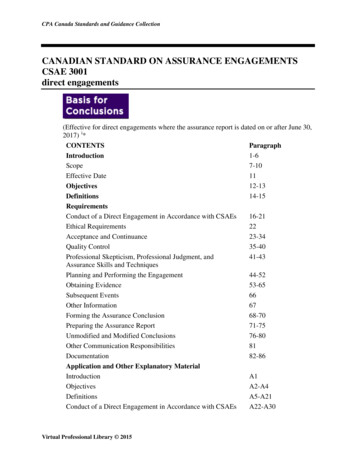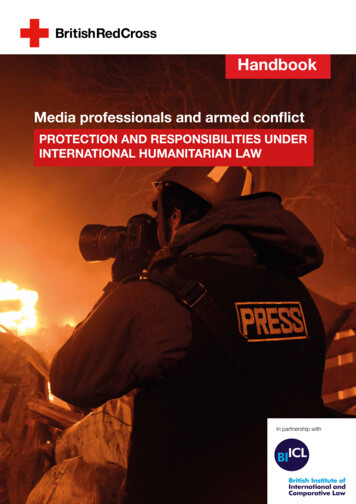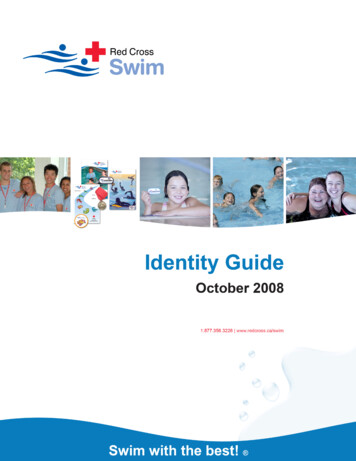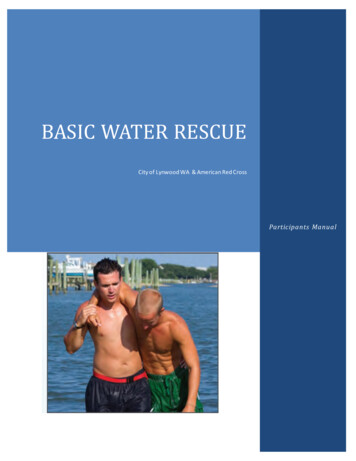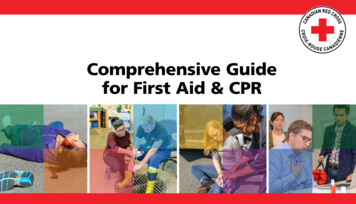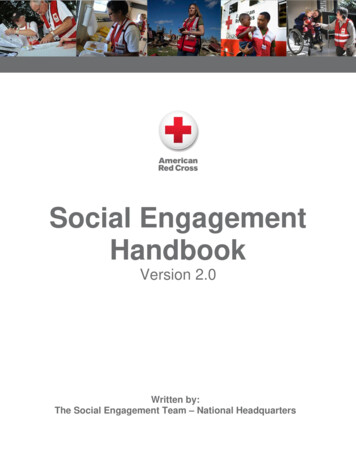
Transcription
Social EngagementHandbookVersion 2.0Written by:The Social Engagement Team – National Headquarters
Social Engagement Handbook 2.0Who:This guide is for all field units associated with the American Red Cross, suchas chapters, blood regions, and SAF stations.What:This guide contains tips and best practices for becoming a socially engagedfield unit for the American Red Cross. It is the 2012 supplement to theoriginal Social Media Handbook.When:Start now, but we don’t expect you to do everything in this guide right away.Social engagement is a long-term commitment. This is a roadmap for buildinga sustainable social engagement strategy.Where:Social networking platforms.Why:The Red Cross is integrating social engagement into our operational DNA tomaintain and innovate our relevance as an organization. We want to empowerindividual Red Crossers, volunteers, and field units to participate in and beinformed by social communities.The Social Engagement team in the NHQ Communications departmentcreates the national social strategy, and encourages all Red Crossers toparticipate in the social web.The benefits to your field unit of being engaged through the social web –such as Facebook, Twitter, YouTube – include: Meet, serve, and steward your community where they spend time Build an everyday relationship with your local stakeholders Increase relevance in your community Increase value to local stakeholders Build fabric of support in your community Help the Red Cross keep the human in humanitarian Increase revenue, course takers, and community participationHow:We are introducing two roles at the Red Cross:Social Engagement Advocates: Any staff member or volunteer who has takenthe social engagement certification course (Social Basics). Advocates areencouraged to use their personal social accounts to engage with others onbehalf of the Red Cross.Social Engagement Specialist: Any staff member who is (1) responsible forcommunity management and generating content for a local field unit and/or(2) trained to engage with the public via the Radian6 Engagement Consoleand/or (3) acts as a disaster digital volunteer.Social Engagement Handbook 2.0American Red CrossPage 1
In 2012, we will begin to offer a social engagement certification course. This course will beavailable to any Red Cross employee or volunteer, so that they can personally participate inthe social web on behalf of the Red Cross. We also encourage each field unit to identify anEngagement Specialist who will have additional training as someone who engages with thepublic using an official branded voice.Please contact Kristiana Almeida, Enterprise Community Specialist, with any additionalquestions, suggestions, ideas, and concerns. Kristiana.Almeida@redcross.org.What does a socially engaged field unit do?Once your field unit commits to sustaining a social engagement strategy for everydayoperations, it can then start to check off each of the below items:Building Capacity to engageMy field unit has adopted a culture of listening, adapting, and inspiringWe have at least one person spending 1 hr/day on social engagementWe are committed to listening to social conversationsWe respond to stakeholders who mention usActivating a Social Engagement StrategyWe proactively foster community on our social platformsWe invite and welcome new people to join our communityWe create original content for our social platformsWe are prepared to continue operations during a major disasterWe are generous to our community members on our platformsWe are a valuable resource to our communityWe are networked with other Red Crossers around the countryWe proactively offer opportunities for our online community to meet offlineInspiring Donations via Social EngagementWe offer our community tools to fundraise on our behalfMeasuring the Impact of Social EngagementWe share community input with operational decision-makersWe inspire offline action (donations, course takers, preparedness)Social Engagement Handbook 2.0American Red CrossPage 2
Build Capacity to Engage on the Social WebAs a social Red Cross field unit, your focus is on empowering your community to get helpand give help. Your social supporters will be invited to help your field unit execute themission of the Red Cross. Keep your focus on providing value and creating a safe, funspace for local residents, groups, companies, and fellow nonprofit organizations tocollaborate on the Red Cross mission.Resource: The real way to build a social networkIdentifying an Engagement SpecialistAt least one person (Engagement Specialist) in your field unit should be responsible foryour unit’s – whether a chapter, SAF station or blood region - social engagement activities.This person can be a volunteer or a staff member for whom social engagement is a priority.Here’s a checklist for identifying the right Red Crosser(s) for this position:Can devote at least 1 hour/day to social engagementHas completed the American Red Cross social engagement certification courseIs familiar with the projects, products, campaigns, operations of your field unitIs willing to use his/her personal social presence to engage stakeholdersHas passion for the social webHas passion for the Red CrossHas technical knowledge about how social tools work, or is willing to be trainedIs willing to be an internal ambassador for social engagementMentors staff and volunteers to become social engagement advocatesIs willing to be an external networker for Red Cross stakeholdersResource: 12 steps to hiring a social engagement managerRecommendations for Managing Official Red Cross Social AccountsMake sure at least two staff members or long term volunteers have administration rightsto the official social accounts. Remember, a staff member or long term volunteer should beresponsible for the social engagement strategy. This person may delegate the day-to-daytactics to an intern or volunteer, but there should be a longer term commitment andcontinuity plan for rotating interns, volunteers, and even staff members.Store the social platform logins and passwords where they can be accessed byappropriate people if needed.Reach out to Kristiana Almeida at NHQ for support and advice at any ning is the foundation of your social engagement program. The tips will help you builda day-to-day listening strategy.Social Engagement Handbook 2.0American Red CrossPage 3
Social engagement means participating in conversations that happen on public socialnetworking platforms such as Facebook and Twitter. Find people who have shared interestin the Red Cross mission by practicing the art of listening.Creating a culture of listeningAll staff and volunteers are encouraged to “listen” and engage on the social web. At leastone staff member or volunteer (Engagement Specialist) should be responsible for listeninga minimum of 1 hour/day.When the Engagement Specialist posts official content, staff and volunteers areencouraged to comment, share the post, and engage with others who comment. Staff andvolunteers are encouraged to participate in the conversation and may provide insights andalerts to the Engagement Specialist about potential engagement opportunities or tomisinformation and misconduct.ToolsWe encourage you to test various listening tools to determine which one works best for youand your unit. Below are a few examples:Desktop osoft Outlook,FeedDemonMobile AppsWeb basedTwitter (officialapp), Hootsuite,TweetDeckFacebook (officialapp), Hootsuite,Feeddler, Kindle,Google otsuite,Google ReaderHow to listen/what to listen forUsing these tools, you can follow specific topics or trends.For example: If there is a tornado warning in your area of Chicago, create a search for“tornado” and “Chicago” in order to provide information, answer questions, and providecomfort as needed.Resource: How to find the most relevant hashtags on TwitterResource: Step-by-Step Approach to listening by Beth KanterAnother best practice is to set up a search for your unit’s name and Twitter handle so youwill see what people are saying directly to or about your unit or the Red Cross.Go to http://www.twitter.comSign into your twitter accountIn the search box, enter your desired keywordSocial Engagement Handbook 2.0American Red CrossPage 4
Click this iconand choose “Save Search”Check this search each dayThe Engagement Specialist should also check your unit’s Facebook page periodicallythroughout the day to engage with those speaking directly to you.All staff and volunteers in your field unit are encouraged to participate in all discussions intheir subject matter areas.The social engagement team in the Communications Department reads and responds to themore than 4,000 daily social mentions of the Red Cross. We then curate this informationinto the Social Media Update to show the day’s conversation trends. If you wish to receivethe Social Media Update via email, email socialmedia@redcross.org and request to beadded to the distribution list.RespondingAddressing questions, acknowledging comments, and contributing to conversations is thenext step to engaging your community. The goal should be to respond to every postdirected to your field unit on social platforms. For example, whenever someone posts toyour Facebook page, you should engage with that person on Facebook, even if it’s a simplethank you.Some people will have social conversations about your field unit or area of expertise thatdon’t directly address your unit. You don’t have to respond to every conversation thatmentions you, but do look for opportunities to educate, provide value, connect communitymembers together, share, and inspire. Challenging comments are often opportunities toincrease understanding of the Red Cross.Talking with your supporters is a good thing. Your conversations should not be talkingpoints – converse with people on social platforms as if they’re your neighbors. They are. Ifyou have any concerns or don’t know how to handle a particular comment, contact KristianaAlmeida at kristiana.almeida@redcross.org.The below flow chart will be helpful when determining when to engage in a conversationabout your unit.Social Engagement Handbook 2.0American Red CrossPage 5
If at all possible, respond to a stakeholder’s question publicly and using the same tool s/heused to contact you initially as your response mechanism. Avoid moving the discussion toemail whenever you can.Social Engagement StrategyFinding your communityThe individuals who join your chapter, blood region, or SAF station’s social communities willhave different levels of interest for the Red Cross that span the ladder of engagement.Our recommendation is to focus on the quality of your community rather than the quantity offollowers. While it may be nice to have 10,000 “happy bystanders” involved, the better goalis to provide value, stewardship, and a sense of belonging to inspire community members tobecome more involved in the Red Cross mission.Social Engagement Handbook 2.0American Red CrossPage 6
Inviting New Stakeholders to join your communityAdd your Twitter handle and Facebook link to your unit’s press releases.Ask your media contacts to follow your unit’s social accounts for fast informationInvite stakeholders at in-person events to join your social communitiesInvite people to join your social community during media interviewsInclude a case study about your social engagement in a web or newsletter storyInclude links to your social presence on your field unit’s homepageInclude links to your social presence in email signaturesNote: Please do not beg for additional followers and likes on your social accounts. Forexample, never post, “Like our page!” to Facebook or “Help us get to 1,000 followers!” onTwitter. Instead, show the potential stakeholder what they’ll get out of being part of yourcommunity. If you post useful, shareable information and prove that you’re listening andengaging, people will want to “like” your page or follow you.Choosing a PlatformYou and your Red Cross unit don’t need to create a presence on every single platform.Through your listening and engaging process, figure out how much capacity (time) you haveand concentrate on the platform(s) where your community spends the most time.At this time, local field units are permitted to host one Facebook page, one Twitter account,one Flickr account, one YouTube account, and one blog. Blood regions are not permitted tocreate local Facebook pages. This means that you cannot create accounts for each line ofservice. We ask that no local field unit create Google , Pinterest, or Instagram accounts. Ifyou would like to contribute to the national G , Pinterest, or Instagram platforms, pleasecontact socialmedia@redcross.org.Creating ContentThe key to empowering your community to participate and enthusiastically share yourcontent is to include them. Your goal is to find the sweet spot between what yourcommunity finds valuable and what your field unit wants them to know or do. Beforeposting content always ask: “What is in it for the community?” and “What about this postwill people find interesting, accessible and useful enough that they’d want to share it?”Social Engagement Handbook 2.0American Red CrossPage 7
Ideas for generating content:1. Are you launching a campaign your community can get involved in? (March is RedCross Month, National Preparedness Month, Holiday Campaign, etc.)?2. Have your donors and/or volunteers made inspiring mission-related impacts you canshare?3. Is your field unit responding to local disasters or deploying volunteers to a nationaldisaster?4. What community activities or events (festivals, drills, parades, etc) is your field unitinvolved in?5. Are there interesting stories in the news that have a connection to the Red Crossmission?6. Do you have an upcoming event the public can join? When is the next CPR/First Aidcourse? Do you have a fundraising event? Heroes Breakfast? Invite your socialcommunity to spread the word, get involved, and attend.7. Can you create or employ an internet meme or popular internet item to inspire actionfor the Red Cross?8. Do you have a unique or inspiring photo or video to share?9. Are you looking for feedback, advice or help? Ask your community to help10. Ask questions, provide value, be generous, be shareable.11. Tell the Communications Department at national headquarters when you’ve comeup with something you’re proud of, including during disasters. Emailmedia3@redcross.orgSocial Engagement Handbook 2.0American Red CrossPage 8
Resource: Engaging Social Engagement ContentRemember, the more creative and engaging posts are, the more likely you will have peopleresponding to, sharing, and acting on them. Be human. Include pictures/video wheneverpossible – you have a greater chance of getting interaction and inspiring action. Have fun,experiment, adapt, and include your community as much as possible.Social Media in a disasterDuring high-visibility disasters, the Red Cross should prevent and alleviate human sufferingin the face of emergencies by mobilizing the power of volunteers and the generosity ofdonors on the social web. Best practices and lessons learned on how to effectivelycontinue social engagement during major disaster operations can be found in the socialengagement guidelines for disaster along with the social worksheet for disasters to help youput a plan in place.Be Generous to your communityGenerosity is a valuable commodity on the social web. Pay attention to your stakeholdersand make them feel great about being part of the community.Participate in #FollowFriday (or #FF) on Twitter. Pick out 3-5 followers who areinteresting or have tweeted with you in the past week, and acknowledge/thank themPublicly thank people for participating in a conversationContribute to conversations. Ask questions and participate in others’ discussions whenrelevantRe-post inspiring content from your community to your field unit’s social platformsBe Valuable to your communityThe Red Cross is a trusted source of many kinds of information, and a trusted source ofhope during difficult times. Providing this information and comfort in the moments whenpeople are looking for it online will help ensure relevance.Be quick and accurateAcknowledge a crisis as soon as possible, but only share confirmed informationBe relevant. Stay attuned to the news and culture to provide real time valueProvide preparedness tips whenever they apply to a situation in your areaWhen there is not a crisis, prepare your community with tips and storiesHost a Twitter chat about specific issues the Red Cross cares aboutParticipate in Twitter chats hosted by others on issues connected to Red CrossLike and comment on your local stakeholders’ Facebook pagesComment on relevant blog posts and online media storiesNetwork with Red CrossersSocial Engagement Handbook 2.0American Red CrossPage 9
National headquarters has created a few ways for you to engage with fellow socialengagement specialists across the country.1) Go to the Red Cross’ Twitter stream and look for the “People” and “Local” liststo look for Red Cross chapters and volunteers/staff who are online. Feel free tofollow a few; but remember, keep your own following list balanced meaningdon’t ONLY follow people from the Red Cross!2) There is now a “Red Cross Social Heroes” group on Facebook that you can joinif you’re looking for social engagement-specific resources. You can also use thegroup to ask questions and share your social successes.Get your Social Community to Meet in Real LifeHere are a few ideas to get your community to grab their smart phones and join you in reallife.TweetupsHost a tweetup to bridge the gap between online and offline relationship building. Invitesocially savvy stakeholders to your chapter or other local space (such as a restaurant forhappy hour) to get to know them, encourage them to get to know one another, and sharethe Red Cross mission.Bleedups: The Central Plains Blood Region has successfully tried severaltweetups for blood donorsCPR Tweetups: The Canadian Red Cross does regular CPR tweetups wherethey invite their Twitter followers to participate in a CPR/First Aid course and tweetthrough the class. This enables your passionate followers to talk openly about animportant courseRed Cross Tweetup: Make your next fundraising event a tweetupSocial Engagement Handbook 2.0American Red CrossPage 10
Inspiring Donations Via Social EngagementThe Red Cross inspires action with its presence on the social web. While we know it’stempting to treat these tools as mass-marketing outgoing channels, research suggests thatfrequently requesting donations causes diminishing returns on engagement. Below isguidance to help your field unit choose the most effective fundraising approaches. Our goalis to respect our communities and to embrace the idea of engagement rather thanpromotion. There is no such thing as an audience on the social web – everyone is a part ofthe community.1) Add the Donate Tab on your Facebook page (note: blood regions are not permitted tohave Facebook pages)An Administrator of your Facebook page logs into FacebookGo to the Donate app pageClick “Add to my page” and choose your page from the drop down menuInvite your local stakeholders with Facebook pages to add the Donate Tab2) Partnering with a CorporationIf a corporation asks you to participate in a joint social engagement project, please contactthe social engagement team at National Headquarters. We will work with the developmentteam to help you evaluate whether the project is a strategic priority for the Red Cross and ofinterest to our community by using the following criteria:o Consider the Company Are its values consistent with those of the American Red Cross? Does the company have an existing relationship or connection with theAmerican Red Cross? Is the corporation active on social networks? Does the company understand our social media philosophy? Does the project offer an expansion or solution to helping ourstakeholders engage with the American Red Cross? What is the fee structure the company is proposing?o What are the benefits to participating in this project? Will it empower our existing stakeholders to act or impact more easilythan they can today? Will the project allow the organization to empower new stakeholders? Will the project create enough revenue to balance the potential capitallost in asking the community to participate? Is the project easy to understand with straightforward action items? Is the project easy to share? Will this project enable the public to transform their online enthusiasmto real world action?o What are the challenges to participating in this project? Is there a danger this project will cause donor fatigue? Do we have the human capital to properly participate? Is this partnership attractive to our target audiences?Social Engagement Handbook 2.0American Red CrossPage 11
Does this project complement our existing donor engagement andsocial media philosophies? Will this project complement our existing communications, marketingand fundraising activities? Does the project have potential to abuse our community’s trust orfrustrate them?We then make judgments based on our previous experience and knowledge of ouraudiences. If the partnership is worth pursuing for the American Red Cross, we willhelp you develop a strategy for executing. 3) Providing fundraising tools to your communityRather than frequently asking for donations, give your community the chance to fundraise onbehalf of the Red Cross themselves. We’ve developed a number of tools you can offer toyour community; our most popular option is our Online Heroes fundraising program.4) New ideasIf you have a brilliant new idea for social fundraising, please contactsocialmedia@redcross.org.5) Sharing your fundraising successIn many cases, sharing your chapter’s exact fundraising goal and progress towards that goalis not appropriate for general audiences. If you have a significant donor story that you canshare as a blog post, that’s great! If you received a nice note in the mail from a donor orrecent disaster victim, you can share a picture of the note (without identifying the author) onyour Facebook wall or Twitter account or blog. Also, if you have had a successful OnlineHeroes campaign, publicly thanking your top fundraisers is a great way to keep themengaged and feeling good about the work they’ve done for your chapter.Measuring the Impact of Social EngagementAs social engagement is integrated into your operations, make a plan to report relevantinformation, trends, action items, successes, and challenges to appropriate decision-makersinternally.MeasurementDevelop several performance indicators against which you measure your social engagementactivity. While it is hard to quantify human relationships, it is possible to demonstrate howyour networking abilities strengthen the fabric of your community, support for the RedCross, the reputation of the Red Cross, and the efficiency and quality of Red Crossservices.Here are tips on how to approach measurement and how to capture data that helpsdemonstrate the efficacy of social engagement:Social Engagement Handbook 2.0American Red CrossPage 12
Wherever possible, tie your community’s social contributions to offline actions. Isyour social community helping to increase blood donations? PHSS course takers?Are people inspired to prepare? To donate?Focus on representing meaningful engagement rather than audience size orimpressions. How many people shared your content with friends? How many left acomment, liked, or replied in some way to you?When looking at traffic or volume of mentions, are there any abnormal spikes ordips? Drill down and figure out what events may have caused these.Compare your data with:o Results from previous time periods (e.g. Mentions of Red Cross in Januaryversus December, or the year before, or two years before)o Other Red Cross related topics (e.g. different lines of business, subjects weare interested in)o Other organizations (e.g. FEMA, Salvation Army)Provide a framework for your data. Numbers and figures need context in order to bevaluable, so give anecdotal evidence of impact from your social monitoring.In order to help gauge which content is most engaging to your audience, you can useFacebook’s new Insights page (only available on organization pages), or look into the linktracking tools available through Hootsuite and Tweetdeck. These tools help you see thereach of your online program and can inform future content decisions.Read more about measuring social activity:Fenton Communications See, Say, Feel, and DoKDPaine’s PR Measurement BlogWeb Strategy by Jeremiah OwyangBeth’s Blog, Measurement CategorySocial Engagement Handbook 2.0American Red CrossPage 13
American Red Cross Social Engagement Handbook 2.0 . Who: This guide is for all field units associated with the American Red Cross, such as chapters, blood regions, and SAF stations. What: This guide contains tips and best practices for becoming a socially engagedFile Size: 532KB
